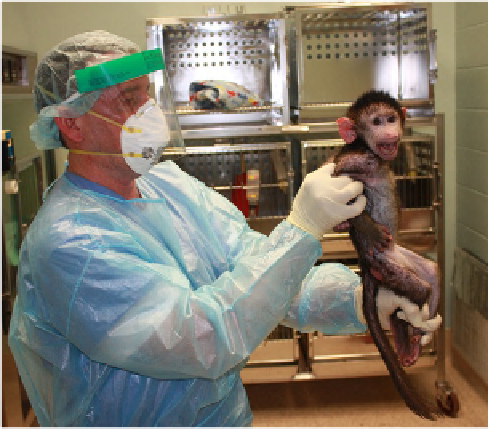Biomedical Engineering Reference
In-Depth Information
netting or hand-capturing, the administration of an anes-
thetic or sedative usually follows.
Anesthetic darting is another means of capture
(
Sapolsky and Share, 1998; Naples et al., 2010
). The blow
dart, which should be mastered in advance of necessity, is
preferable to the dart gun in that it produces less trauma at
a closer range than the compressed gas model. However,
a compressed air rifle or handgun has a greater range,
especially when shooting upwards. They are also capable
of shooting a larger dart containing more anesthetic agent.
To cause as little trauma as possible and to have the anes-
thetic take effect as rapidly as possible, aim should be for
a large muscle group. The thigh or shoulder muscles are
generally the targets of choice. Once darted, it is best to
keep the subject as calm as possible, away from its group,
and away from potential hazards. Also, the spent dart must
be policed as soon as possible to avoid injuries.
Moving nonhuman primates from large corrals and
group cages to a location where they can be handled can be
accomplished with attached races. First, the group must be
trained to shift into and through the race. Negative rein-
forcement or avoidance learning, wherein the nonhuman
primate acts to avoid a given provocation, has traditionally
been used when shifting nonhuman primates. However, an
undesirable sequela to this approach is the necessary
escalation of the negative stimulation as the animals
become accustomed to it. Therefore, it is critical to
understand that when using an aversive method, it is
absolutely essential that the negative stimulation cease
immediately upon the outset of the desired action. Shifting
nonhuman primates with positive reinforcement should be
used instead. In this case, a reward, such as food or treats, is
given after the animals have moved to the desired location.
By using positive reinforcement, one group of nonhuman
primates was trained to shift (
Veeder et al., 2009
). Shifting
became quicker and less stressful than before training.
Transfer boxes are commonly used to transfer
nonhuman primates from one location to another.
A transfer box is affixed to the cage where the nonhuman
primate is located. The door to the transfer box is opened
followed by the door to the cage. Preferably, a treat is
placed in the transfer box, enticing the animal to enter.
Alternatively, another technician can move behind the
animal which may motivate it to shift into the transfer box.
If the nonhuman primate is in a squeeze-back cage, the
back can be advanced forward, leaving the animal no
choice but to enter the transfer box. Once the nonhuman
primate enters the transfer box, the door is quickly closed.
Confident control is a prerequisite to thorough clinical
examination and evaluation, and a necessary condition
before biological samples for analysis are obtained or
therapy is administered. There is no substitute for an
abundance of practical experience when performing any
type of nonhuman primate restraint and certainly no
equivalent to professional judgment when selecting the
method best suited to accomplish the tasks at hand.
Elements of unpredictability associated with animal work
can be magnified significantly when handling intelligent,
agile, and often powerful nonhuman primate species.
Ability gained through vigilant practice and a studied
knowledge of proven techniques is mandatory for consis-
tently safe outcomes (
Bennett et al., 1995
).
Manual Restraint
Small and/or young nonhuman primates weighing less than
5 kg may be restrained manually (
Figure 13.2
). Appropriate
personal protective equipment (PPE) should be worn, and
manual restraint should not be attempted alone. Once the
animal is hand-captured, netted, or immobilized in
a squeeze-back cage, it can be manually restrained by
grasping both forelimbs and positioning them so that the
elbows effectively touch one another behind the animal. It
is then possible to convert the two-handed hold to a single
hand, freeing one hand to restrain the lower limbs by
grasping the two ankles. It is best to use the least amount of
force necessary to immobilize the animal and release in
a controlled manner as soon as possible.
Restraint Devices
Restraint devices can offer increased safety for animal and
personnel over manual restraint methods and of course are
Restraint
Animal restraint, that is, restricting an animal's ability to
move, is generally accomplished by the veterinarian or
animal technician immediately following animal capture.
FIGURE 13.2
Restraint of a 2- to 5-kg nonhuman primate.





